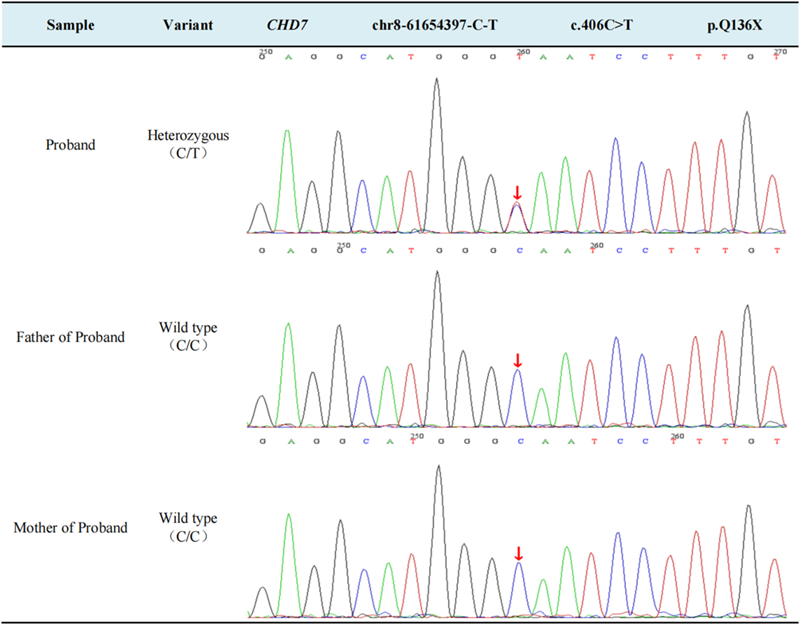Study Reveals How Fetal Ear Shape Could Signal Rare Genetic Condition | BGI Insight
2024-05-02

First linked to mutations in the CHD7 gene in 2004, CHARGE syndrome is a rare genetic disorder occurring in approximately 1 in 8,500 to 15,000 births. According to National Institute of Health (NIH), CHARGE syndrome is an acronym for coloboma of eyes (C), heart disease (H), atresia of the choanae (A), retarded growth and mental development (R), genital anomalies (G), and ear malformations and hearing loss (E). Diagnosis is often challenging because this disorder manifests differently across individuals.
A recent study published in Clinical Case Reports explored the detection of CHARGE syndrome through prenatal ultrasound observations of fetal ear abnormalities. Spearheaded by Yu Liang from Shijiazhuang Fourth Hospital and Sijie He, a specialized scientist from BGI Genomics, this research underscores the crucial role of early genetic screening and prenatal diagnostics.
Case Background and Research Method
A pregnant woman, expecting her second child but with no previous live births, visited Shijiazhuang Fourth Hospital for a prenatal check-up. Ultrasound scans were performed at weeks 22, 28, 33, and 35 of the pregnancy. The initial detection of an abnormal ear shape at 22 weeks gestation prompted suspicions of CHARGE syndrome. However, the pregnant woman declined invasive prenatal testing after genetic counselling. After birth, comprehensive assessments, including physical exams and whole exome sequencing, confirmed the diagnosis.
Key Findings
- Potentially Difficult to Diagnose: The CHD7 mutation is not listed in the public Genome Aggregation Database and has been predicted to be harmful by renowned genetic analysis tools like CADD and Mutation Taster. Without genetic testing, it is difficult to determine the condition during pregnancy and even after birth. In this case, the parents declined further invasive prenatal testing. Due to the absence of other significant supporting evidence, it was difficult to confirm the CHARGE syndrome through ultrasound alone.
- Phenotypes vary: The phenotypes were highly variable, and no clear correlation has been found between the severity of the phenotype and mutations in specific domains of the CHD7 protein. Despite a month of nutritional support, the disease continued to progress. Eventually, the parents refused any curative treatment and allowed for only supportive care.
- Mostly De Novo, Sometimes Inherited: To confirm a suspected genetic disorder, Trio-Whole-Exome Sequencing (Trio-WES) were applied on the newborn and the parents. The test revealed a nonsense mutation chr8-61,654,397-C-T (GRCh37/hg19) in CHD7 gene (ENST00000524602 c.406C > T, p.Q136X in exon 2) of the newborn, which was absent in the parents. This particular mutation is likely to cause an early disruption in protein formation, potentially leading to significant functional impairments as outlined by American College of Medical Genetics and Genomics (ACMG) mutation interpretation guidelines.
 Sanger sequencing results. Trio-WES genetic analysis revealed that the newborn has a nonsense mutation, while this mutation was not found in the parents. The specific location of the mutation is clearly indicated by arrows in the results.
Sanger sequencing results. Trio-WES genetic analysis revealed that the newborn has a nonsense mutation, while this mutation was not found in the parents. The specific location of the mutation is clearly indicated by arrows in the results.
The Importance of Early Diagnosis
CHARGE syndrome, a congenital anomaly with a high mortality rate, underscores the importance of early prenatal diagnosis for effective management. The researchers recommend conducting ultrasound exams between the 20th and 24th weeks of pregnancy to detect fetal ear abnormality. If any irregularities in the ear's shape, size, or position are detected, a specialized genetic test for the CHD7 gene associated with rare diseases should be carried out to confirm the diagnosis. This approach provides a window for timely interventions and enhances our understanding of rare genetic conditions, improving future diagnostic protocols.
Sijie He, specialized scientist, BGI Genomics, further advises, “For cases where abnormalities are found during ultrasound examination during pregnancy, it is recommended that pregnant women receive genetic counselling, prenatal diagnosis and genetic testing to confirm the diagnosis, which can effectively control birth defects.”
Introducing BGI Genomics XOME cWES
cWES is intended for use in conjunction with the clinical presentation and other markers of disease progression for the management of patients with rare genetic disorders and especially heterogeneous phenotypes. cWES sequences over 180,000 exons across 22,000 genes for more than 4,000 monogenic diseases.
About BGI Genomics
BGI Genomics, headquartered in Shenzhen, China, is the world's leading integrated solutions provider of precision medicine. Our services cover more than 100 countries and regions, involving more than 2,300 medical institutions. In July 2017, as a subsidiary of BGI Group, BGI Genomics (300676.SZ) was officially listed on the Shenzhen Stock Exchange.
Read more:
Advancing Newborn Genetic Screening Through Prenatal Carrier Screening
Enhancing High-risk Infant Outcomes with Newborn Genetic Screening in China